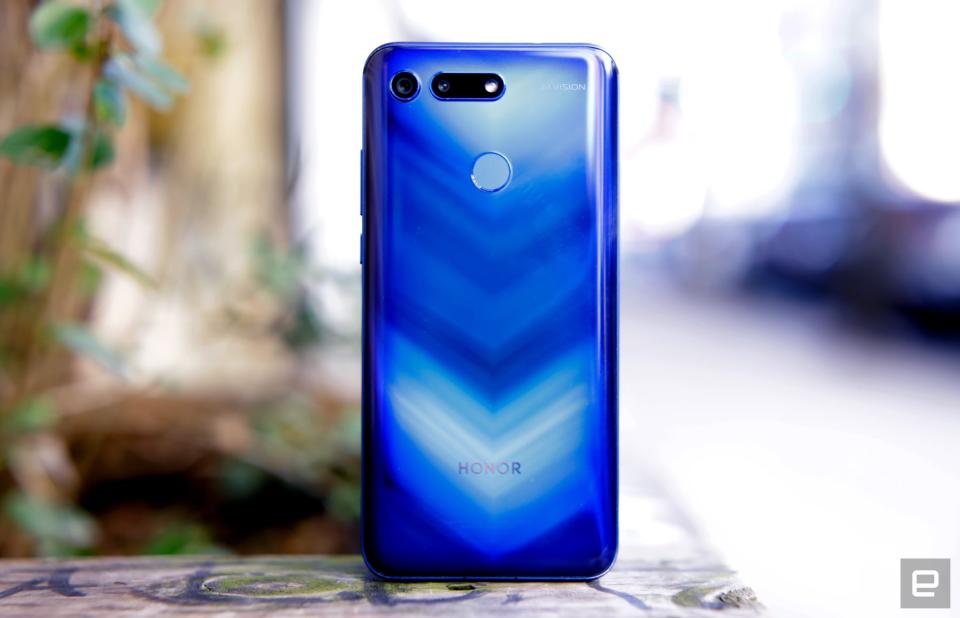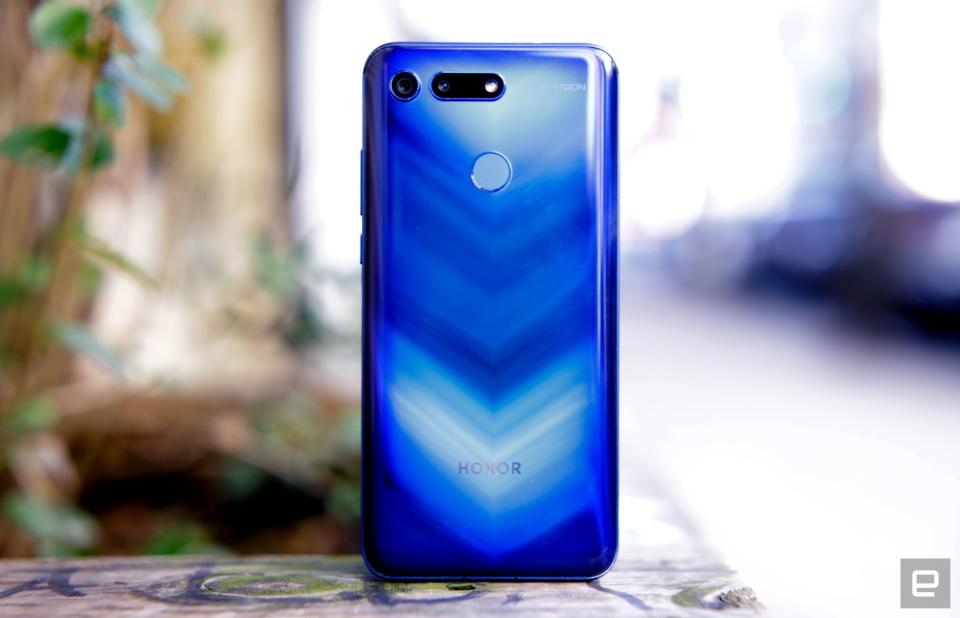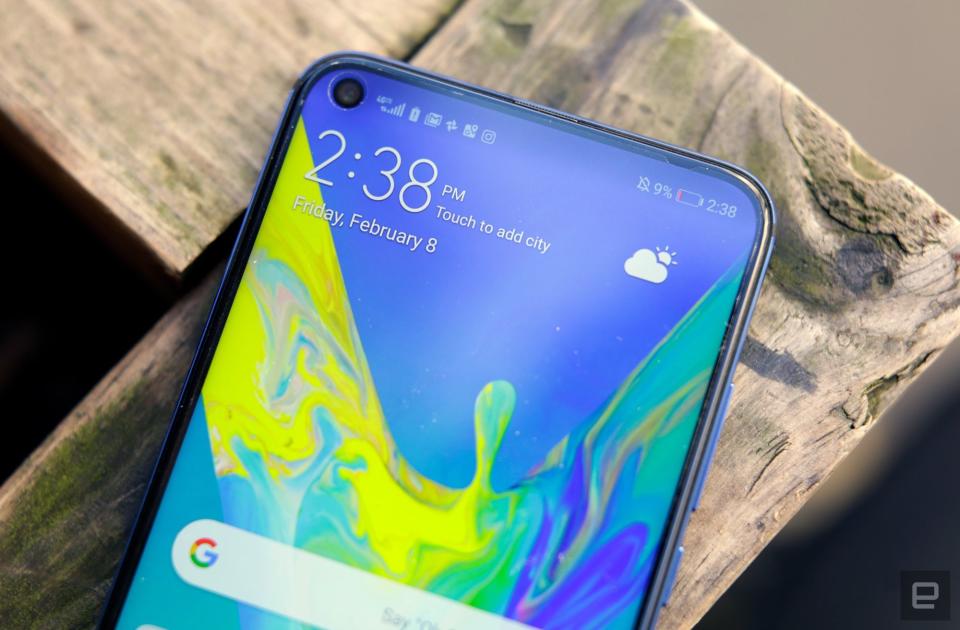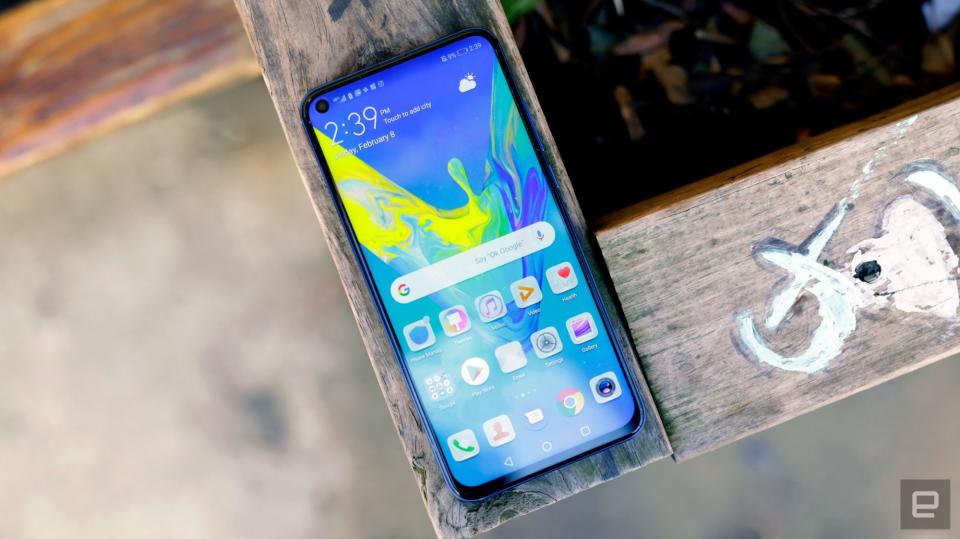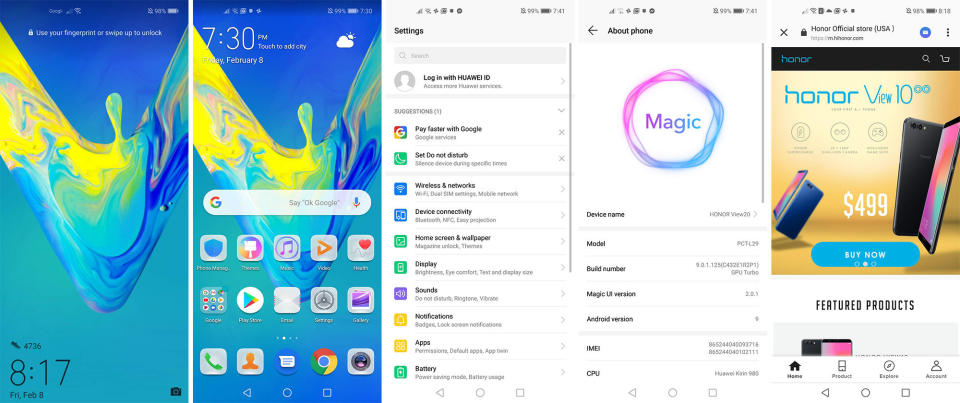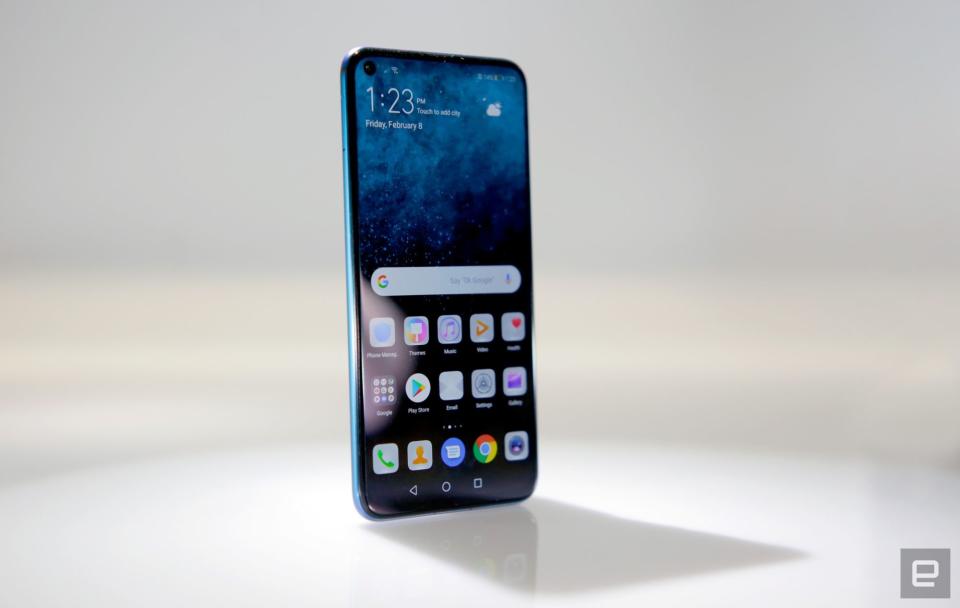Honor View 20 review: Gorgeous, affordable and out of reach
Huawei's $600 best of CES finalist has style in spades, but what about everything else?
"Glamorous" isn't the first word that springs to mind when thinking of Honor smartphones, but to my surprise, it actually fits the Honor View 20 quite well. And why shouldn't it? With an eye-catching design, an ambitious camera and one of the world's first widely available hole-punch displays, the View 20 seems well-equipped to take on rival devices from companies like OnePlus and Xiaomi. The fact that it only costs around $600 is just icing on the cake.
Of course, not everyone will get the chance to use one. Honor, if you're not familiar, is a brand built and owned by Huawei, the Chinese electronics giant that's currently facing serious legal pressure from the United States government. Huawei's plans to bring the Honor View 20 to the US were pretty nebulous even before those lawsuits were filed, and at this point, we'd be surprised if this phone made an official appearance in North America anytime soon. That's too bad. Smartphone makers of all stripes are busy making premium devices with more reasonable price tags, but few of them pack the allure and technical savvy that the View 20 does.
Hardware & Design
We're suckers for pretty hardware, and the View 20 definitely fits the bill. It doesn't take long for the phone's design to suck you in, either: the first thing you'll notice is the phone's gleaming glass back, engineered so that light refracts in a signature V pattern. I'm a fan (especially of the red model Honor didn't give us), though I can see how it would come off a little gaudy to some. Say what you will about Huawei, but few smartphone makers are as ambitious when it comes to crafting new finishes. That glass back also houses the snappy rear-mounted fingerprint sensor and a whopper of a dual camera.

And of course, we need to talk about this display. The race is on to eliminate the dead space around smartphone screens, and if 2018 was the year of the notch, 2019 is gearing up to be the year of the hole-punch. The cut-out houses a 25-megapixel front-facing camera and, like notches before it, you'll almost certainly stop noticing it before long. And naturally, it takes up much less space than a "traditional" notch -- having a screen that stretches entirely across the phone's face is worth the mild weirdness of seeing a hole cut out of a corner.
It helps that Huawei has generally done a good job making sure the camera hole never really gets in the way. Icons that pop up in the notification bar are shifted slightly to the right, and in general, the software here is smart enough to keep the hole from obscuring crucial UI elements. If it turns out the hole really isn't your thing, though, it can be obscured entirely with a black bar.
As novel as this notch-less design is, the 6.4-inch IPS panel that actually surrounds that camera hole leaves us with a little less to get excited about. This LCD runs at 2310 x 1080, and while it's far from the most outright impressive screen I've ever used, it has been pleasant enough in day-to-day use. During my week of testing, I never had trouble reading or framing up photos on the View 20 in broad daylight, and its colors are seriously punchy for an LCD, too. In fact, the point some would argue they're a little too punchy -- thankfully, there are options to tune the color mode and temperature.
So yeah, the View 20 is a striking device to behold. More importantly, the phone is remarkably comfortable to use. Other devices in this price range, like the excellent OnePlus 6T, feature glass backs and slim edges that make the phone more difficult to grip. The View 20's edges are a little thicker, and for me at least, it makes a noticeable difference in stability. Rounding out the package is a decent single speaker that suffers from the same issue as most phone speakers: it's decently loud but lacks any depth. But, rejoice! Huawei included a standard headphone jack.
The biggest knock against the View 20's hardware is its of lack of wireless charging and IP-rated water and dust resistance. I can forgive the former, but as someone who has drowned at least one phone just by running in the rain, Huawei's promises of splash resistance don't fill me with much confidence.

In use
The View 20 has much more going for it than just good looks. Tucked inside is one of Huawei's 980 chipsets, that delivers serious speed /and/ really impressive battery life. Overall performance depends on what version of the View 20 you're working with, though: our review unit has 8GB of RAM and 256GB of storage, while the less-expensive base model ships in a 6GB/128GB configuration.
As a result, you shouldn't be surprised to hear that this version of the View 20 generally runs like a dream. My daily routine has never proved to be much trouble for high-powered devices like this; at any given time, you'll probably find me firing off messages, playing music in Spotify, triaging my Gmail account and more. If anything, the View 20 got more of a workout once the work ended.
When digging into some truly embarrassing PUBG and Fortnite matches, the Kirin 980 and its Mali G76 GPU kept things running incredibly smoothly, to the point where I didn't notice a single dropped frame in either game. This doesn't come as a huge surprise, especially where Fortnite is concerned: when the phone officially launched at a glitzy press event in Paris, Huawei said would be the first Android device to run the game at 60FPS). And when all that run-and-gun humiliation was over, the View 20 nimbly kept up while exploring the lush worlds of Another Eden. These graphical loads didn't stymie the phone one bit, and not once did I even consider firing up the View 20's "performance" mode. This feature allows the Kirin 980 to run full-throttle with little respect for battery life and device temperature, but the option hardly feels necessary here.

That's not to say everything is perfect here. Like other Huawei phones though, there's a tiny delay between the moment you swipe the screen and when the interface actually reacts. I'm not exactly sure whether this latency is due to Huawei's software or if it's a problem with the touchscreen. In general, the minute lag isn't annoying enough to distract from whatever task is at hand, but it stands in stark contrast to devices like the Pixel 3 and the OnePlus 6T, where that kind of input lag barely exists at all.
Overall, the Kirin 980 chipset offers mostly excellent performance, and it's enough to give any Snapdragon 845 device a run for their money. Because of the way the chipset's eight cores were designed, they also squeeze a lot of battery life from the View 20's 4,000mAh cell. After a full day of frequent use, the View 20 would routinely have 40 to 50 percent left in its battery when it was time for bed. If you only use your phone sporadically, you could easily get away with charging the View 20 every other day — maybe even every three days, if you're lucky.

Unfortunately, some of Huawei's software decisions drag down this otherwise impressive hardware. The View 20 ships with Android 9.0 Pie and that would be great news if it weren't painted over so thoroughly with the Honor Magic UI. Honestly, I'm not sure why Huawei bothered giving this interface a different name at all because it's essentially identical to the EMUI 9.0 interface the company debuted on the Mate 20 Pro. That wouldn't be a problem if EMUI wasn't so dumb sometimes.
For instance, lock screen notifications can be sort of a mess. By default, you're only shown your latest notifications, not the full list that have rolled in since you last checked. Fine, I can see the rationale there. My biggest issue so far though has been with Gmail: Even the app pre-installed and fully functional, I've never received a notification on my lock screen. A quick trip to the phone's notification settings revealed the problem: there was, for whatever reason, no way to push Gmail notifications to the lock screen. Beyond that, interacting with items on the lock screen requires a tedious double-tap -- you were probably better off just unlocking the phone altogether. Oh, and our review unit suffers from a bug where Android's navigation keys shift to the left a bit after rotating the phone from landscape to portrait. It's a minor thing, but attention to detail matters, people. If I were you, I'd trade this not-so-Magic UI for an alternative launcher ASAP.

The camera
If you've considered buying a camera in the past fifteen or so years, someone has probably told you that more megapixels don't necessarily make for better photos. The same is true of smartphone cameras, but I have to give Huawei some credit for squeezing a 48-megapixel Sony camera sensor into the View 20. It's total overkill, but it's fun.
To be clear, though, you won't be firing off 48-megapixel stills right out of the box — nor should you be. The View 20's camera shoots at 12-megapixels by default, and since the phone lumps multiple pixels on the sensor to act as bigger individual pixels, the resulting pictures are very solid, even in low light. Colors are pleasant enough (especially with the AI camera mode enabled) and in general, there's more detail to be found while pixel-peeping a 12-megapixel View 20 photo than with one taken by, say, an iPhone XS. Switching into the full 48-megapixel mode means you'll wind up with larger files, but I haven't noticed a meaningful difference in quality between the phone's 12MP and 48MP photos -- the latter just let you zoom in more.

That all changes once you fire up the camera's AI Ultra Clarity mode. To get the most detailed images possible, the phone shoots and combines a handful of 48-megapixel exposures into a single shot — think of it as Huawei's general-purpose take on Night Mode. Given enough light and very steady hands the results can be astoundingly crisp.
I've spent the past week reviewing some Ultra Clarity shots and randomly zooming around to see how legible minute details were, and so far, the gimmick hasn't gotten old. Even expensive flagships can't really keep up with the View 20 — 48-megapixels is a lot of data, after all, and the way Ultra Clarity stitches those exposures together adds some new dimensions to the final photos. The feature does, however, have its caveats: shooting an Ultra Clarity photo takes five seconds (ideally, nothing in the frame moves during this period), and if your hands move a little too much, some of those fine details could be smoothed out into oblivion.
The bigger question here is whether all of this extra detail this sensor captures ultimately makes for better pictures, and the answer is "not really." Ultra Clarity photos are indeed highly impressive when the conditions are right, but the amount of time needed to shoot them means you probably won't be using the feature constantly. The View 20's standard 48-megapixel photos pretty detailed themselves, though (as mentioned) the phone's 12-megapixel stills usually turn out a little nicer. And overall, photos taken with devices like the Pixel 3 feature more pleasing colors and dynamic range -- even though those files don't feature the same level of detail, they're the ones I'd prefer to look at more often. The old wisdom holds true: resolution isn't everything.
Of course, that 48-megapixel camera isn't alone. It's accompanied by a secondary time-of-flight sensor that's meant to make the View 20 better at isolating faces in portraits. The camera does a respectable job of isolating the subject from its background, but it's not always great at figuring out where an object's edges are, and the results aren't much to write home about. The most interesting — and problematic — use of this time-of-flight sensor is in a beauty mode called "Shaping" that makes people look thinner. Yikes.
The 25-megapixel front camera is further proof that resolution isn't everything. You'll need to find bright, even lighting to get the best results, as things tend to very get grainy otherwise. That's true of all front-facing cameras, but I was hoping Huawei would be able to work some software magic and turn all 25 megapixels of data into something above-average. I was wrong: the results here were average at best, and I'd take a Pixel 3's selfie camera any day, lower resolution be damned. I appreciate Huawei's tepid attempt to improve selfies by throwing more pixels at the problem, but maybe a more conventional approach would've been better.

Wrap-up
On the surface at least, the Honor View 20 seems like the smartphone fan's smartphone. It's beautifully built, packs some serious horsepower, and that hole-punch display offers a taste of the near-future — that's not a bad package for $600. Sure, Huawei's sometimes-amateurish futzing with Android Pie means it isn't a great choice for Google purists (those folks would be better served by a Pixel 3 or a OnePlus 6T) and most of the time that oft-hyped camera is good, not great. If you live in a part of the world that hasn't completely blacklisted Huawei hardware, the View 20 is a worthy, if not astounding, option.
For now, at least, continued tension between Huawei and the US government means the odds of being able to buy one of these in a big-box store grow slimmer by the day. While those of us in North America probably won't experience what the View 20 brings to the table anytime soon, we'll still probably benefit from the phone's release elsewhere — in some ways, Huawei raised the bar for what to expect from a high-end, low-cost smartphone, and we're sure to see other companies follow suit this year.

